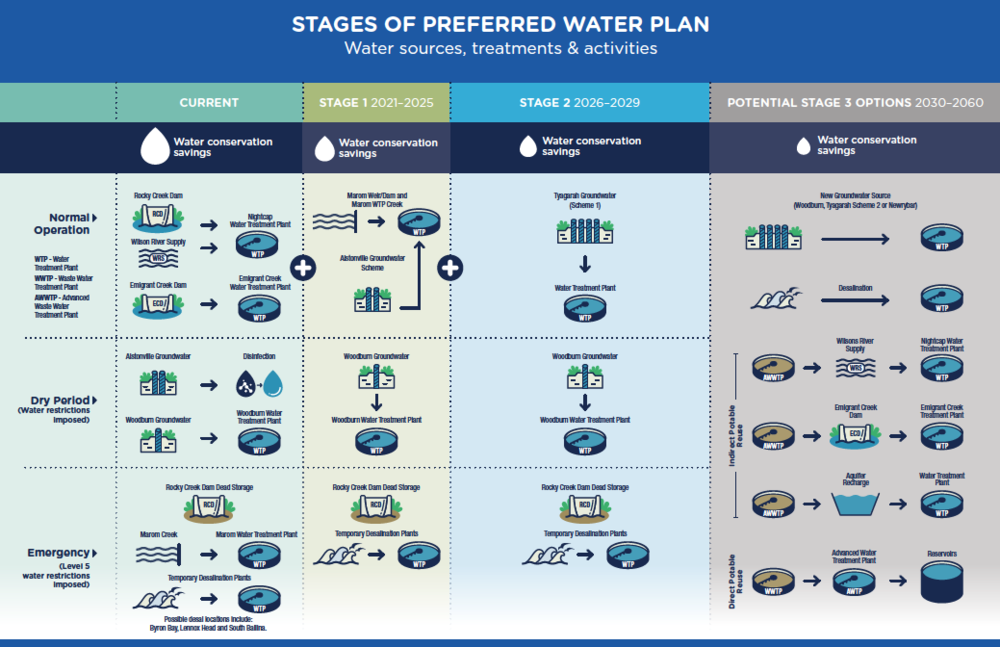Rous have a new future water supply plan now Dunoon Dam is dead
Simon Mumford
30 March 2021, 6:24 PM

Rous County Council has finalised its revised Future Water Project 2060 plan now that the Dunoon Dam option is off the table and they are looking for community feedback starting tomorrow April 1, 2021.
Activating existing groundwater sources full-time in Alstonville and utilising underground aquifers in Tyagarah now form the centrepiece of Rous County Council’s draft document.
Rous’ revised strategic direction also recommends implementing more innovative water-saving measures and finding ways to overcome the barriers to using purified recycled water for drinking purposes in NSW.
While the new direction provides innovative options to secure water into the future that acknowledges climate change, it will also mean the cost of water will increase for each ratepayer. More on this later in the story.
Ballina Shire, Byron Shire, Lismore City and Richmond Valley residents will be able to provide feedback when the revised draft Future Water Project 2060 goes on public exhibition for eight weeks from Thursday, 1 April 2021 until Friday, 28 May 2021.
“Our revised approach provides a suitable alternative following the decision last year not to proceed with further investigations into the Dunoon Dam,” Rous County Council’s Chairperson Keith Williams said.
“Despite this refocus, the critical water security challenges facing our regional supply from forecast population growth and changing climate conditions still remain.
“Transforming the local government-owned bores around Alstonville into a primary water source is a priority, especially as it will ensure we can keep up with forecast demand from 2024.
“The revised future water project sets out a staged approach under which additional groundwater sources are gradually brought online, while at the same time enhanced demand management initiatives and potential purified recycled water schemes are identified,” Chairperson Williams said.
Some of the key water supply security actions covered by the revised draft Future Water Project 2060 include:
• Securing the upgrade of the existing Marom Creek Water Treatment Plant to permanently supply the Wollongbar and Alstonville communities in addition to Wardell etc., and redevelop existing groundwater bores within the Alstonville aquifer to provide drought resilience.
• Investigating two new potential schemes for eventually utilising groundwater from the Tyagarah area as a primary supply.
• Rolling out smart water metering for all of Rous’ 2,000 direct retail customers.
• Instigating a four-year plan to further address water loss from the Rous supply network.
• Pioneering the use of purified recycled water by building a pilot treatment plant and direct potable reuse scheme to supply the Perradenya Estate near Lismore.
• Investigating indirect potable reuse schemes
General Manager Phillip Rudd said Rous would like to hear from as many residents as possible over the next two months.
“We’re always looking to improve engagement with communities across our entire service area, especially in relation to critical regional issues such as water security and the use of new water sources,” Mr Rudd added.
As mentioned these new water sources will add to our water bills each quarter as they come online.
Basically, a dam is on higher ground that gravity feeds water to a number of reservoirs in our region that is then distributed to households.
When you extract water from the ground that is 200 metres deep like in Alstonville, you need pumps to complete the process. You then need treatment plants to remove the contaminations found in the water before it is then pumped to reservoirs then households.
As you can imagine Rous County Council has the capital cost of building and maintaining the main extraction pumps, treatment plants and pipelines to existing reservoirs with the daily running costs.
Drinkable re-cycled water is a real unknown as it has not been done in Australia before so the pilot project at Perradenya Estate, Caniaba is an Aussie first. The costs associated with its success are completely unknown but believed to be more than operating and running a dam so again the cost of water will increase.

This latest water supply plan is formed until 2030 when all other options will be considered such as a desalination plant.
We are in a delicate situation where the majority of Australians believe in climate change and want to play their part in the planet's survival. That survival is a trade-off and comes at a cost. At this stage, we just don't know what that exact price is.
Residents can visit the project’s dedicated webpage at www.rous.nsw.gov.au/futurewater to find out more and provide any feedback from tomorrow Thursday, 1 April 2021.

